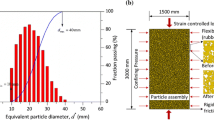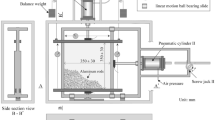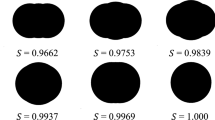Abstract
This paper examines the development and evolution of shear bands in granular assemblies when particle rolling and imperfections are taken into account. Simulated biaxial tests in two-dimension are conducted using the discrete element method. The progressive development of rotational angles and effective strain are presented to describe the emergence and evolution of shear bands in biaxial tests. The simulated results reveal that when rolling resistance is taken into account in DEM, the development of shear bands is more distinct as the evolution of the minor shear bands is limited while the major shear bands are preferably promoted in granular materials, and that the local rotating bearings not only influence the onset of shear bands and the width of the shear bands, but also decrease the resistance and reduce the strength of the granular material. Also, it is demonstrated that the primary shear bands initiate from the imperfect areas and develop preferentially along the direction of imperfections. Therefore, the emergence and development of shear bands, which will result in a decline in strength and eventually lead to instability and destruction of the material, can be effectively simulated when rolling resistance is incorporated in DEM and the initial distribution of imperfections in the granular material is defined.



















Similar content being viewed by others
References
Cundall, P.A., Strack, O.D.L.: A discrete numerical model for granular assemblies. Geotech 29, 47–65 (1979)
Chang, C.S., Misra, A.: Packing structure and mechanical properties of granulates. J. Eng. Mech. 116, 1077–1093 (1988)
Zhang, D., White, W.J.: An efficient calculation method for particle motion in discrete element simulations. Powder Technol. 98, 223–230 (1998)
Oda, M., Iwashita, K.: Mechanics of Granular Materials. Ballkema, Rotterdam (1999)
Al-Raoush, R.: Microstructure characterization of granular materials. Phys. A 377, 545–558 (2007)
Hare, C.L., Ghadiri, M.: Influence of measurement cell size on predicted attrition by the Distinct Element Method. Powder Technol. 236, 100–106 (2013)
Oda, M., Konishi, J., Nemat-Nasser, S.: Experimental micromechanical evaluation of strength of granular materials: effects of particular rolling. Mech. Mater. 1, 269–283 (1982)
Oda, M., Takemura, T., Takahashi, M.: Microstructure in shear band observed by microfocus X-ray computed tomography. Geotechnique 54, 539–542 (2004)
Bardet, J.P.: Observations on the effects of particle rotations on the failure of idealized granular materials. Mech. Mater. 18, 159–182 (1994)
Veje, C.T., Howell, D.W., Behringer, R.P.: Kinematics of a two-dimensional granular Couette experiment at the transition to shearing. Phys. Rev. E 59, 739–745 (1999)
Åström, J.A., Herrmann, H.J., Timonen, J.: Granular packings and fault zones. Phys. Rev. Lett. 84, 638–641 (2000)
Alonso-Marroquín, F., Vardoulakis, I., Herrmann, H.J.: Effect of rolling on dissipation in fault gouges. Phys. Rev. E 74, 031306-1–031306-10 (2006)
Iwashita, K., Oda, M.: Rolling resistance at contacts in simulation of shear band development by DEM. J. Eng. Mech. 3, 285–292 (1998)
Oda, M., Kazama, H.: Microstructure of shear bands and its relation to the mechanisms of dilatancy and failure of dense granular soils. Geotechnique 48, 465–481 (1998)
Iwashita, K., Oda, M.: Micro-deformation mechanism of shear banding process based on modified distinct element method. Powder Technol. 109, 192–205 (2000)
Tordesillas, A., Stuart Walsh, D.C.: Incorporating rolling resistance and contact anisotropy in micromechanical models of granular media. Powder Technol. 124, 106–111 (2002)
Jiang, M.J., Yu, H.S., Harris, D.: A novel discrete model for granular material incorporating rolling resistance. Comput. Geotech. 32, 340–357 (2005)
Mohamed, A., Gutierrrez, M.: Comprehensive study of the effects of rolling resistance on the stress-strain and strain localization behavior of granular materials. Granul. Matter 12, 527–541 (2010)
Feng, Y.T., Han, K., Owen, D.R.J.: Some computational issues numerical simulation of particulate systems. In: Fifth World Congress on Computational Mechanics, Vienna, Austira (2002)
Li, X.K., Chu, X.H., Feng, Y.T.: A discrete particle model and numerical modeling of the failure modes of granular materials. Eng. Comput. 22, 894–920 (2005)
Tejchman, J.: Effect of fluctuation of current void ratio on the shear zone formation in granular bodies within micro-polar hypoplasticity. Comput. Geotech. 33, 29–46 (2006)
Borja, R.I., Song, X.Y., Rechenmacher, A.L., Abedi, S., Wu, W.: Shear band in sand with spatially varying density. J. Mech. Phys. Solids 61, 219–234 (2013)
Herrmann, H.J.: Granular matter. Phys. A 313, 188–210 (2002)
Vardoulakis, I., Graf, B.: Shear band formation in fine-grained sand. In: Proceeding of Fifth International Conference Numerical Methods in Geomechanics, Nagoya, Balkema, Rotterdam (1985)
Oda, M., Iwashita, K.: Study on couple stress and sear band development in granular media based on numerical simulation analyses. Int. J. Eng. Sci. 38, 1713–1740 (2000)
Chu, X.H.: The discrete particle and coupled discrete-continuum models and numerical methods for granular materials. PhD dissertation, DLUT, Dalian (2006)
Acknowledgments
This work was financially supported by the National Natural Science Fund of China (11172216), the National Key Basic Research and Development Program (973 Program, 2010CB731502), and the Fundamental Research Funds for the Central Universities (DUT14LK20).
Author information
Authors and Affiliations
Corresponding author
Appendix
Appendix
The definition of effective strain for granular materials is briefly summarized.
To measure the change in position of a particle in relation to neighbouring particles, a nominal strain (i.e., the effective strain) is defined at the centre of the particle. Considering the change in position of particle A in relation to one of its neighbouring particles, denoted particle B and shown in Fig. 20, the nominal effective strain is defined as follows.
In Fig. 20, the relative change in position of two neighbouring particles at times \(t_1 \) and \(t_2 \) is considered. Using the XYZ global coordinate system, the centre coordinates of particles A and B are \(\mathbf{X}_\mathrm{A}^\mathrm{1} \),\(\mathbf{X}_\mathrm{B}^1\) at \(t_1 \) and \(\mathbf{X}_\mathrm{A}^\mathrm{2} \), \(\mathbf{X}_\mathrm{B}^2 \) at \(t_2 \). The angles between the axis in the XYZ global coordinate system and the corresponding xyz local coordinate system are \(\alpha _1 \), \(\beta _1 \), \(\gamma _1\) at \(t_1 \) and \(\alpha _2 \), \(\beta _2\), \(\gamma _2 \) at \(t_2 \). The difference between the centre positions of particles A and B, using the global coordinate system, at \(t_1 \) and \(t_2 \) are
The differences based on the local coordinate system can be expressed as
The coordinate transformation result is
where \(\mathbf{T}_1 \) and \(\mathbf{T}_2 \) are the coordinate transformation matrixes from the local coordinate system to the global coordinate system at \(t_1 \) and at \(t_2 \), respectively.
It means that by revolving \(\beta _1\) around axis \(y_1 \), then \(\gamma _1\) around axis \(z_1 \) at \(t_1 \), the local coordinate system can coincide with the global coordinate system. Similarly, by revolving \(\beta _2\) around axis \(y_2 \), then \(\gamma _2\) around axis \(z_2 \) at \(t_2 \), the local coordinate system can coincide with the global coordinate system.
As two-dimensional problem concerned, only the coordinate transformation within XY plane is considered [20]. The coordinate transformation matrixes are
Deformation gradient f is used to describe the relative location change between particles A and B, from the material particle pair \(A-B:\mathbf{X}_A^1 -\mathbf{X}_B^1 \) at time \(t_1\) , to the same material particle pair \({A}'-{B}':\mathbf{X}_A^2 -\mathbf{X}_B^2 \) at time \(t_2 \) , referred to as \(x_1 -y_1 \), where f is defined as:
In Eq. (8), \(\mathbf{R}\) is the orthogonal tensor, which represents the rotation of the connecting line between particles A and B. \(\mathbf{U}\) is a positive definite symmetric tensor, which represents the tensile deformation of the connecting line between particles A and B. They can be expressed as
Equations (4), (7), and (8) result in
According to the theory of continuum mechanics, the derivative tensor of the displacement gradient, defined by the relationship between the material coordinate and space coordinate, is
where \(\mathbf{I}\) is the unit matrix. If \(D_{ij} \) are the components of matrix \(\mathbf{D}\), then
where \(\gamma _{\mathrm{AB}} \) is an intermediate variable, and \(\gamma _\mathrm{e} \) is the effective strain at the centre of particle A, around which there are \(n_\mathrm{A} \) neighbouring particles.
Rights and permissions
About this article
Cite this article
Tang, H., Dong, Y., Chu, X. et al. The influence of particle rolling and imperfections on the formation of shear bands in granular material. Granular Matter 18, 12 (2016). https://doi.org/10.1007/s10035-016-0607-3
Received:
Published:
DOI: https://doi.org/10.1007/s10035-016-0607-3





